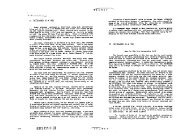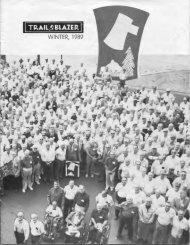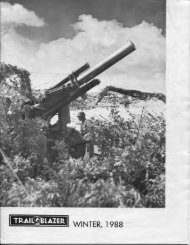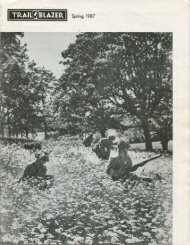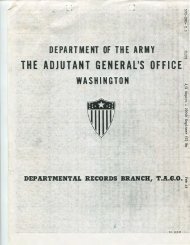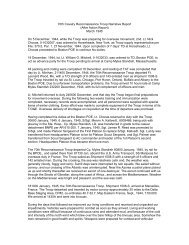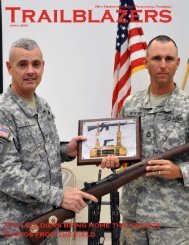Download - 70th Infantry Division Association
Download - 70th Infantry Division Association
Download - 70th Infantry Division Association
Create successful ePaper yourself
Turn your PDF publications into a flip-book with our unique Google optimized e-Paper software.
From 29 December 1944 to 1 January 1945 the 276th <strong>Infantry</strong> held its defensive sector along the Rhine.<br />
Combat efficiency was reported as excellent.<br />
On December 29, 1944 we departed Bischwiller at 1300 and arrived at about 1400 in Seltz, France. We<br />
traveled these 15 miles by truck convoy. If I remember correctly, the trucks were "alligators", big landing<br />
craft the <strong>Infantry</strong> used in the Pacific quite frequently for landing from ship to shore. The "alligators" were<br />
landed in France with the intention of crossing the rivers. Of course, you would use any transportation you<br />
could get.<br />
On December 31, we departed Seltz at about (unreadable) in the morning and we arrived at Beinheim at<br />
about 8:30. 'We traveled these thre miles by convoy. We departed Beinheim at 1445 by truck and arrived<br />
at Camp d'Oberhoffen around 1600, a distance of about 12 miles. On January 2, we departed Camp<br />
d'Oberhoffen by truck at 1500 and arrived at Ingwiller. France at 6:30 p.m., 16 miles away.<br />
On 1 January 1945 the regiment, now attached to the 79th <strong>Infantry</strong> <strong>Division</strong>, moved by motor and<br />
marching to Camp d'Oberhoffen, its defensive positions along the Rhine being taken over by the 274th<br />
<strong>Infantry</strong>. The mission of the 296th <strong>Infantry</strong> in its new location was VI Corps Reserve, and tactically<br />
involved only local security. The Regiment was ordered to remain assembled, prepared to move to the<br />
Mouterhouse area.<br />
During afternoon of 2 January 1945 the Regiment began movement by motor to Zittersheim, France, to<br />
continue its VI Corps Reserve mission by preparing, occupying and defending a position extending from<br />
Volksberg to Ingwiller, a distance of 11 miles. At this time the 276th <strong>Infantry</strong>, which had been attached to<br />
the 79th <strong>Division</strong>, was attached to the 45th <strong>Division</strong>. The new position was occupied during the late<br />
afternoon and night of 2 January 1945 with the 2d Battalion on the right extending from Ingwiller to<br />
Wimmenau inclusive, the 3d Battalion on the left extending from Volksberg to Wimmenau exclusive, and<br />
the 1st Battalion in reserve south of Wingen.<br />
Administrative reports now listed needed replacements as 2 officers and 232 enlisted men. Rations were<br />
sufficient for three days and oil and gas for one day. The ammunition report showed a shortage of hand<br />
grenades and efforts were being made by S-4 to fill this deficiency. There were no damaged vehicles and<br />
none on request.<br />
The 276th <strong>Infantry</strong>, having occupied positions as shown on an overlay from the 45th <strong>Division</strong>, at once<br />
began to improve them and to install road blocks. One platoon of Company I was attached to the 180th<br />
<strong>Infantry</strong> and remained with the 180th <strong>Infantry</strong> all during the battle of Wingen.<br />
The 2d Battalion at 0730 on 3 January 1945 reported to the Regimental CP at Zittersheim the loss of one<br />
Regimental AntiTank gun, attached, and part of Company E.<br />
Two artillery shells burst in the 3d Battalion area during the morning and at 1010 that battalion reported<br />
90 per cent of the civilian population was evacuating Rosteig, moving west on foot toward Volksburg. A<br />
column of French medium tanks and armored cars appeared at Volksburg at 1030 and the French captain<br />
in command conferred with the commanding officer of our Company K to coordinate action. Later in<br />
the day the captain of French Armored Forces reported to the CP of the 276th <strong>Infantry</strong> for coordination.<br />
By January 4, we were starting to get into combat. We were in battle position. We departed Ingwiller by<br />
foot at 1530 and arrived at 1730 in battle position, 8 miles north of Ingwiller, France.<br />
At 1215 the 3d Battalion reported that Companies C and B of the 179th <strong>Infantry</strong> were withdrawing through<br />
the first platoon of our Company I, while Company A of the 179th was moving north around our left flank<br />
to counter-attack.<br />
The 1st Battalion, preparing positions to defend Wingen, was shelled and lost one man. This was<br />
reported at 1455. Shelling of the 3d Battalion CP at 1625 required moving the CP to a new position.



